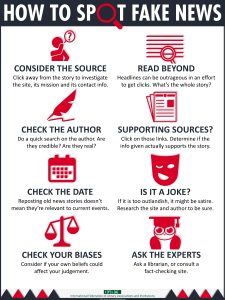People today have greater access to information than they did in any other time in human history, but not all of that information is equally as useful to us. For every piece of trustworthy news available, there are countless others that may be misleading, incomplete, or entirely false. It begs the question: how do you know if a source is trustworthy?
How Does Media Literacy Education Benefit Everyone?
Strong media literacy skills create a better educated populace and reinforce support for organizations delivering accurate news. Creating this better-informed world starts in the classroom, with students who can think critically about where information comes from.
5 Ways to Get Reliable News
Finding news sources that consistently provide accurate information can be daunting, but there are some strategies students can use to identify when a piece of news can be trusted. Read on to learn how to tell if a source is trustworthy.

1. Check for other sources reporting the same information
Unless a story is very new, accurate news stories will be reported by multiple sources. Resources like Google News or Apple News will aggregate stories from multiple sources and create an easy way to check if a story is being reported by a variety of outlets. If some time has passed since the publication of a story and no other news sites have picked up the story with reporting of their own, you should be more skeptical of whether or not that story is true in the first place. It’s possible that that story is still accurate, but news that is only reported by a single source is more likely to be unreliable than news that is corroborated by reporting from multiple sources.
2. Identify a source’s funding
Knowing where a news organization gets its money from can be helpful for understanding what the motivations are for posting certain stories. Organizations that receive the bulk of their funding from subscriptions, like The Washington Post or The Wall Street Journal, have a different relationship to their readers than organizations that rely on in-page advertising, which prioritizes amassing the greatest number of clicks.
Some media sources receive their funding from local or national governments, but not all government-funded media is the same. An organization that receives its funding from the government but retains editorial independence, like Radio France, is quite different from an organization that is both funded by and administered by a government entity, like China’s Xinhua. Knowing the structure of state-funded media can help you consider potential biases in reporting.
3. Look for information about the reporter
Most news items should have a by-line, or the name of the person who wrote the story. Looking for more information about a reporter, like other stories that they have reported or their previous journalistic experience, can help you understand their perspective and identify any personal biases.
If a news item doesn’t have a reporter, it can be a red flag that the source is not transparent about how its reporting is done. It can also be a sign that an article is not intended as news in the first place. Editorial writing, for example, often doesn’t have a byline attached because editorials are opinion pieces meant to represent the views of all of the editors of a publication. Editorials shouldn’t be used as direct sources of information, but they can be a starting point for further research.
4. See how the source addresses corrections
Even the most respected news organizations make mistakes sometimes, and addressing those mistakes is an important sign of how much a source values accuracy. Corrections should be noted somewhere in the news story itself, usually at the beginning or the end, and include what information was changed and when. Many trustworthy media sources will include an entire page of its website noting all of their corrections, like The New York Times’s corrections section. Mistakes are inevitable, and trustworthy news sources will be clear about when they occur.
5. Evaluate how well a headline matches the story
The point of a headline is to draw in readers and make them want to learn more about a story, but a trustworthy news source will never sacrifice accuracy in a headline for the sake of generating interest. A “clickbait” headline twists or misrepresents part of a story to make it seem more interesting than it really is so people who might not otherwise be interested will click to learn more. Some headline tactics like posing a question or being intentionally vague may be annoying but aren’t necessarily clickbait; trustworthy news sources may use these tactics, but no reputable source will include falsehoods in a headline.

How to Find Trustworthy Sources: Critical for News Consumers
Figuring out which news sources are trustworthy may seem daunting at first, but the more students practice identifying good sources of news, the easier it becomes. Reliable news sources can in turn help you find other reliable sources, and eventually students can build up a list of go-to sources for learning more about the world as we know it.
Image credits: News on phone (ID 131140526 | News Phone © Tero Vesalainen | Dreamstime.com); Infographic (How to Spot Fake News by IFLA is licensed under CC BY 4.0)


